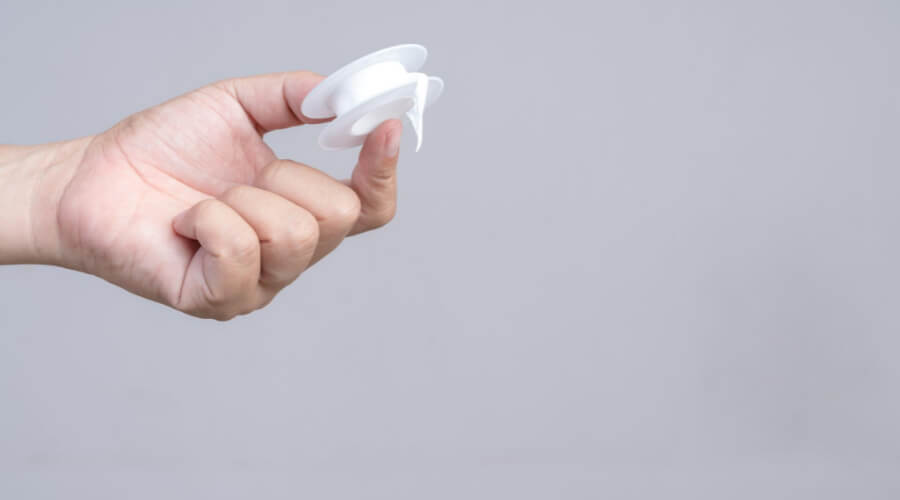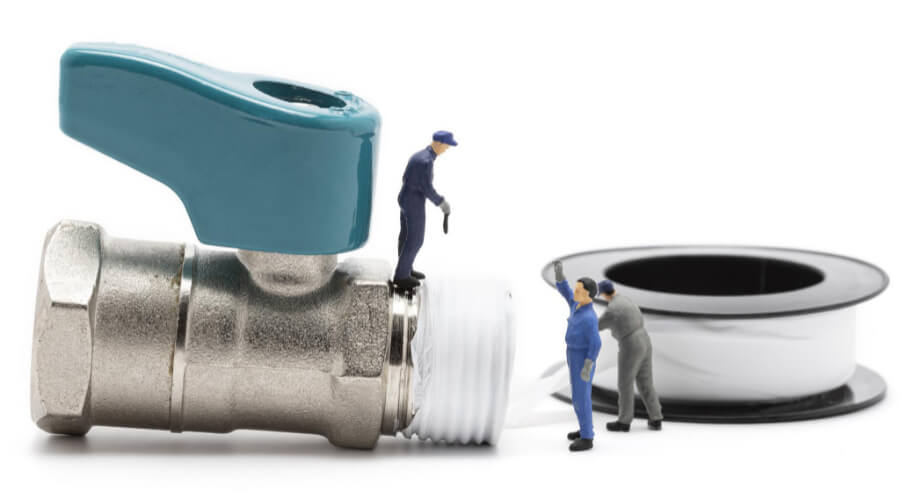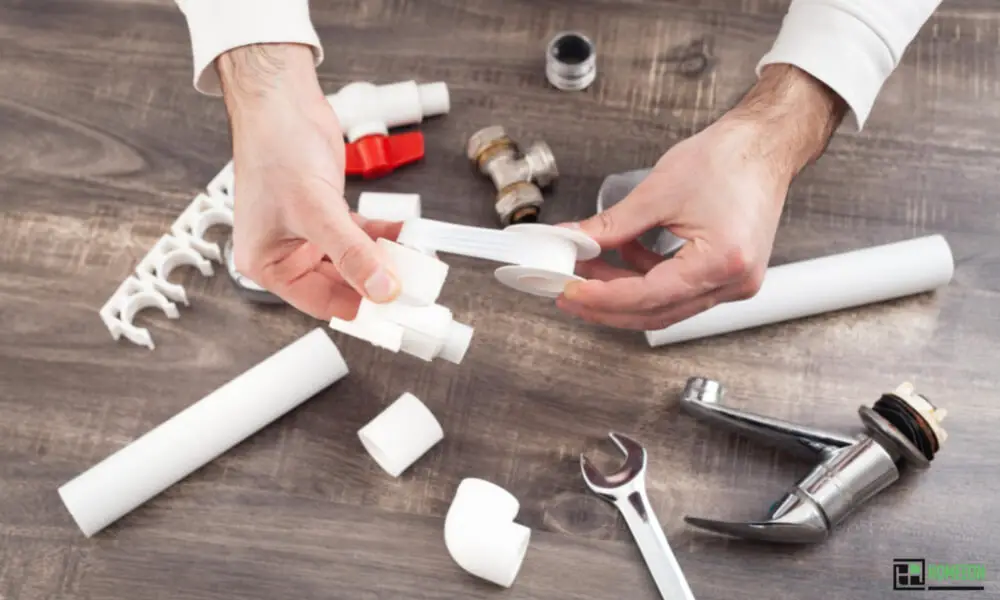Last Updated on July 22, 2023 By Emma W. Thomas
Teflon tapes, are available in various size ranges to suit different applications. Typically, they come in widths of 1/2 inch, 3/4 inch, and 1 inch, with lengths varying from 260 inches to 520 inches. The size chosen depends on the specific sealing or plumbing needs in industrial and household settings.
Jump To A Section
The Size Range Of Teflon Tapes
| Size (Width x Length) | Application |
|---|---|
| 1/4″ x 260″ | General purpose tape suitable for most plumbing applications. It is commonly used for sealing small-size pipe threads and fittings. |
| 1/2″ x 260″ | A popular size tape suitable for various plumbing and industrial applications, including showerheads, faucets, and pipe connections. |
| 3/4″ x 520″ | A wider tape is designed for larger pipe threads, such as those used in industrial settings or for connecting water mains. |
| 1″ x 520″ | Primarily used in heavy-duty industrial applications, this size is suitable for sealing large pipe threads, valves, and pumps. |
| 2″ x 520″ | A significantly wider tape is mainly used in industrial settings where exceptionally strong sealing is required for large pipe joints. |
How Do You Decide On The Teflon Tape Size To Buy?

When buying Teflon tape, you have to consider the size of the thread to be wrapped. You do not want to buy oversize tape that will clump on your pipe, leaving an unprofessional look. The table below is a Guide on the Teflon tape width and the thread size suitable for each.
| Teflon Tape Width | Size Of Threads |
| ¼ inch | 1/8 inch to ¼ inch threads |
| ½ inch | 3/8 inch to 2’’inch threads |
| 1 inch | 3” to 4” threads |
| ¾ inch | ¾ inch through 2” threads |
What Are The Properties Of Teflon Tape?

Teflon tape is an inexpensive tape used to join pipes by sealing them in plumbing. It is also used to seal gas to prevent leaking when the threaded connection does not have built-in rubber. The tape has the following properties that make it unique compared to other tapes;
It Is Highly Waxy
Teflon tape’s waxy property is what makes it the perfect choice for plumbers and electricians. The waxiness helps it stick more and for a longer time compared to other tapes. It is also used to fix insulations, threads, and coils due to its waxy property. Teflon tape can coat plumbing threads and components, creating a tighter seal than any other sealing tape.
It Is Versatile
Its versatility enables the tape to withstand a wide temperature range of between -2700 to 2600. Its ability is due to some chemical resistance used during manufacture. It helps the tape to remain unsusceptible to any chemicals. The Teflon tape is only affected by some alkali metals only under set conditions. Its versatility enables it to withstand all weather conditions providing a wider range of uses.
Wide Range Of Sizes
Teflon tapes come in various size ranges in both width and thickness. In thickness, it ranges from 0.002 inches to 0.125 inches. For the width, adhesive Teflon tapes range from 0.003 inches up to 0.1 inches, while a normal Teflon tape has a width range of 1/2- inch to 12 inches. Such a range makes it suitable to repair longer tubes and little cables.
It Is Non-reactive
Teflon tapes are non-reactive, resulting from the strong carbon-fluorine bonds used during manufacture. Its non-reactive property makes the tape perfect for use as a lubricant due to its low friction. When used on machinery, it reduces the energy consumed and possible wear and tear resulting from friction. It is mostly used in pipework and containers involved in reactive and corrosive chemicals.
Are There Alternatives For Teflon Tapes?
Teflon tape has a wide range of uses, but sometimes, it is not the best option for the job. There are other cases where tape application is impossible due to lack of enough space. In other cases, pipes have undergone wear and tear, and using Teflon tape will only worsen the case. You will need to go for other alternatives to seal up your pipes. Some of these alternatives include;
Valve packing is a different form of Teflon tape used on pipes with a ridge or connections with large gaps. It functions by bushing the broken pipe at the connecting point.
Pipe dope is a common name for pipe joint compounds made by mixing up components like ethanol, oil, rosin, and clay. The combination creates a liquid that serves as a sealant and also a lubricant for pipe joints. When using pipe dope, you must be keen on the point of application since some are unsuitable for use, especially where gas or explosive liquids such as petrol are concerned.
What Are The Uses Of Teflon Tapes?
Teflon tapes are also known as Polytetrafluoroethylene(PTFE). It is made of hydrophobic components making it water-resistant hence no liquid can make it wet. The water resistance ability makes Teflon tape the perfect choice for using water system connections or places involved in acidic corrosion as it is non-reactive. It is also used in high-pressure lines, which are associated with chemical reactions.
There are different Teflon tapes, each serving different purposes, making it difficult to generalize its uses. They are usually coded in different colors to ensure you buy the right tape for the right purpose. The different Teflon tapes and their uses include;
Pink Teflon Tape
Teflon tape used in sealing water lines is coded in pink color. Its heavy density characterizes it compared to other standard Teflon thread seal tapes. Pipefitters and plumbers usually use it in connecting water pipes and joints.
White Teflon Tape
It is also known as a basic thread seal tape. White is the code color used for all thread sealant tapes used for basic plumbing. A basic thread seal tape is present in almost all households as it serves a wide range of uses, including non-professional and less critical situations. Despite its availability, it also contains all PTFE features, including high chemical resistance, versatility, and waxiness to seal threaded connections tightly.
Grey Teflon Tape
Grey Teflon tape is used on stainless steel. It is characterized by its high-density rates, making it appear like a double-thread seal tape. Its thickness makes it suitable for large threaded pipes to prevent galling and seizing by taping steal threads. If the steel connection has a gasket or rubber seal, grey Teflon tape should not be used.
Yellow Teflon Tape
Yellow-coded Teflon tape is the only safe thread seal tape for all gas-type lines, including butane, propane, and natural gas. Using the right tape is very important, especially where gas is involved since a minor leakage can lead to an explosion claiming lives and property. Yellow Teflon tape makes it easy and quick to seal gas lines. It meets all worldwide gas company standards making it the perfect tape.
Green Teflon Tape
They are also known as green oxygen tapes. They are only used in oxygen applications due to their grease-free nature. They do not support combustion; hence a fire cannot start when applied in oxygen-carrying pipes or containers.
How Do You Use Teflon Tape Correctly?
Teflon tape may not be difficult to use, but it is still not a walk in the park. Using it is not the same way you put it on other tapes. How you apply is important for the sake of the future and the present. A poor application can cause major problems when you want to take off and re-apply the tape.
Before applying the tape, it is important to consider its direction. The tape must be tightly wrapped around the pipe. You only achieve this by wrapping the Teflon tape in the opposite direction the pipe turns when rotated. Wrapping it in that direction will ball up the tape and can lead to a leakage. Below are some steps you can consider using as a guide;
- Wipe the pipe clean and dry. Even though the Teflon tape is water and liquid-resistant, the wrapping point must be dry to be effective. Teflon tape applied on a dry surface lasts longer while still intact than one applied on a wet surface.
- Position one end of the Teflon tape on another thread from the end of the pipe and hold them in place using your fingers.
- Start wrapping the tape in the opposite turning direction of the pipe. The turning direction of the pipe and the direction you are driving the tape must be opposite to prevent clumping and balling up. Keep the tape firmly held for you to come up with a tight wrap on the threads.
- Decide on the number of times the Teflon tape will be rounded on the pipe, depending on how thick the tape is. For a standard Teflon tape, five to six wraps are enough. You do not want an outward bulging wrap that appears unprofessionally done. You also do not want it to be too thin, which might cause a leak, despite applying the Teflon tape. When choosing the thickness of your tape, you should first consider the size of your pipe to avoid having a very thin or very thick tape unsuitable for your application.
- After wrapping up the Teflon tape on the pipe, tug it off strongly. Smoothen up the loose tape end on the pipe and the job is done.
Conclusion
Teflon tapes come in different sizes, densities, and colors depending on their intended use. There are white Teflon tapes that are used for basic wraps. Yellow Teflon tape is used for wrapping gas pipes and lines. Yellow Teflon tapes are thicker and have more density than any other Teflon tape type.
References:
https://www.iqsdirectory.com/articles/tape-suppliers/ptfe-tape.html
Emma is a graduate of Domestic Science or Family and Consumer Sciences (Home Economics) from the University of Wisconsin. She has 7 years of experience Working with the strategic section of BestBuy and now writing full-time for Homeeon.
From Managing the Home, Interiors, Cleaning, and Exteriors to Gardening and everything about Making A Home Liveable – is her passion and this Homeeon is the result of this.
Emma loves decorating her home with the best stuff found online. She cares about quality over anything and writes reviews about them here in Homeeon. Get in touch with her over Pinterest.
Keep reading her blogs.
